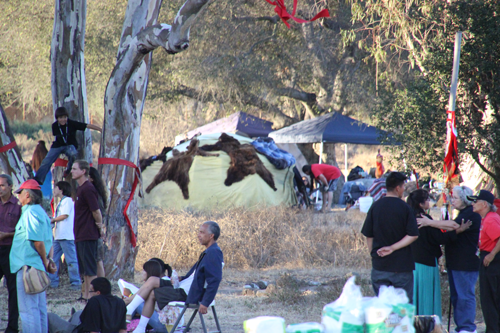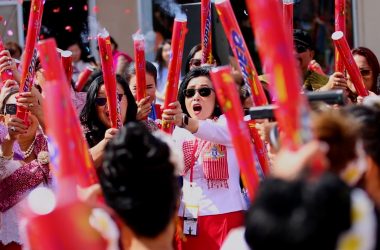Hillside and Parkside College residents heard the faint sounds of drumbeats and native songs Saturday night, when the annual Ancestor Walk came to Puvungna, the sacred Native American land next to Parkside.
What looks like a field of weeds used to be an Ajachamen village that covered all of the Cal State Long Beach campus until the beginning of the 19th century. According to Jan Sampson, a CSULB alumnus who graduated through the Indian studies department, it has never ceased to be a cultural, historical and religious site.
Native American community members traveled together through seven different sacred sites from San Clemente to Long Beach throughout Saturday, sunrise to sunset. The culminating ceremony is held at Puvungna, which Sampson said is one of the most sacred of the still-remaining sites.
Members of groups from Ajachamen, Tongva, Kiowa and Apache all gathered at the sacred site as the sun fell to remember their ancestors as well as respect the elders that sat around the circle, enjoying and exchanging potluck food.
“As native people, we try to be in an alliance with other native people,” attendee Ayopechtli Wind said. “We all have underlying similarities, and we like to support them and their ways.”
Smoke from the fire and sage filled the air, transforming the site into a gathering of ethereal people in anticipation of the Bear Dance ceremony that was to take place after sundown.
The event also remembers creator Lillian Robles, who in 1993 stayed on this land of the Gabrelino-Tongva people for an extended amount of time to fight the development of a strip mall, according to Sampson. Today, the native peoples are still able to use the land to pray, reflect and celebrate.
Robles created the first Ancestor Walk 17 years ago, and before she passed, she asked that her daughter Rebecca continue the legacy.
According to Sampson, members of the native American community visit Puvungna nearly every day, ensuring that it remains untouched and respected. She said she worries about the new university president coming to Cal State Long Beach, because it is necessary to re-educate each new authority about the undying importance the land has to the native people.
“Sometimes [the school doesn’t] understand how important this site is [to the native people],” Sampson said. “Every time we hear the school wants to develop out here or take parts of the land, it hurts so bad.”
The songs performed during the ceremony were native social songs, influenced by their animal brothers and the elements, according to Josie Montes of the Culture Traditions program at Sherman Indian high school. Others were ceremonial songs played by multiple types of woodwinds, sometimes accompanied by heavy drumming and song.
Some of the performers were young girls from the program. According to Montes, they are taught to “walk in a good way,” abstaining from drugs and alcohol and practicing being good community members. They build some of their own instruments, including the drums they were using during the performance of their social songs.
“Song has a lot of medicines,” Montes said. “[The girls] know they can always turn to music … to their drum.”
Part of the importance of the tradition is sharing it with youth so that respect and maintenance of the land can be maintained across generations.
“On a daily basis students learn to respect ancestors, honor the four directions, the heart of sky and heart of earth,” one of the elders said over the microphone in between the songs presented.
A tight circle of tents was set apart from the main circle, where Sampson said eight spiritual leaders had been preparing to symbolically transform themselves into bears. They spent hours in a private sweat lodge ceremony, praying and cleansing themselves of negative energies so that they could bring unity and healing to the community.
After the sun went down, children chased each other around the edges of the sacred circle, some wearing faux bear hides of their own. The crowd was encouraged to call for the bears to enter, followed by a dead silence heavy with anticipation. According to attendee Ehecatl Wind, this anticipation is a purposeful part of the ceremonial process.
The drum beat louder as the bears entered the circle, stepping heavily and slowly as the majestic creatures do, some opening up to the fire and revealing their painted faces as they growled.
The bears danced to multiple songs, and everyone was invited to participate and be healed. A line of people entered the sacred circle and spiraled around the fire. While some of the attendees were not native by blood, all were welcome to participate in the healing ceremony.




